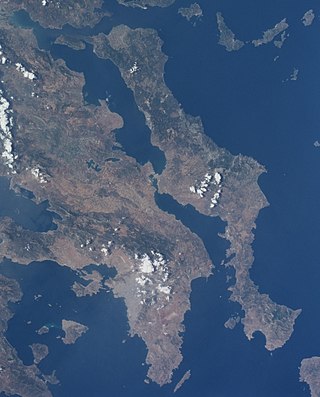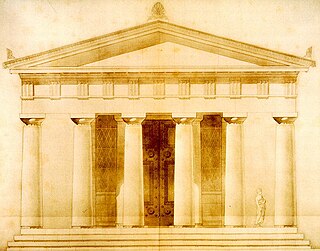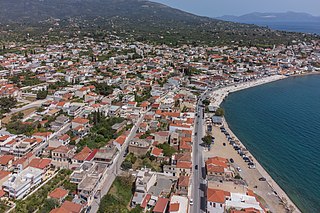Related Research Articles

In ancient Greek religion and mythology, Artemis is the goddess of the hunt, the wilderness, wild animals, nature, vegetation, childbirth, care of children, and chastity. In later times, she was identified with Selene, the personification of the Moon. She was often said to roam the forests and mountains, attended by her entourage of nymphs. The goddess Diana is her Roman equivalent.

In ancient Greek mythology and religion, Leto is a goddess and the mother of Apollo and Artemis. She is the daughter of the Titans Coeus and Phoebe, and the sister of Asteria.
In Greek mythology, Otrera was the founder and first Queen of the Amazons; the consort of Ares and mother of Hippolyta and Penthesilea. She is credited with being the founder of the shrine of Artemis in Ephesus.

Eileithyia or Ilithyia was the Greek goddess of childbirth and midwifery, and the daughter of Zeus and Hera. In the cave of Amnisos (Crete) she was related with the annual birth of the divine child, and her cult is connected with Enesidaon, who was the chthonic aspect of the god Poseidon. It is possible that her cult is related with the cult of Eleusis. In his Seventh Nemean Ode, Pindar refers to her as the maid to or seated beside the Moirai (Fates) and responsible for the creation of offspring. Her son was Sosipolis, who was worshiped at Elis.

Euboea, also known by its modern spelling Evia, is the second-largest Greek island in area and population, after Crete, and the sixth largest island in the Mediterranean Sea. It is separated from Boeotia in mainland Greece by the narrow Euripus Strait. In general outline it is a long and narrow island; it is about 180 km (110 mi) long, and varies in breadth from 50 km (31 mi) to 6 km (3.7 mi). Its geographic orientation is from northwest to southeast, and it is traversed throughout its length by a mountain range, which forms part of the chain that bounds Thessaly on the east, and is continued south of Euboia in the lofty islands of Andros, Tinos and Mykonos.

The Temple of the Delians is the largest of the three Greek temples dedicated to Apollo within the temenos of the Sanctuary of Apollo on the Greek island of Delos. This was one of slightly more than a dozen Panhellenic sanctuaries in Ancient Greek religion and attracted visitors from across the Hellenic world. It is also known as the Great Temple or the Delian Temple of Apollo.

Eretria is a town in Euboea, Greece, facing the coast of Attica across the narrow South Euboean Gulf. It was an important Greek polis in the 6th and 5th century BC, mentioned by many famous writers and actively involved in significant historical events.
Oropus or Oropos was a town on the borders of ancient Attica and Boeotia, and the capital of a district, called after it Oropia This district is a maritime plain, through which the Asopus flows into the sea, and extends for 5 miles (8.0 km) along the shore. It is separated from the inland plain of Tanagra by some hills, which are a continuation of the principal chain of the Diacrian mountains.

Lycosura was a city in the ancient Parrhasia region of south Arcadia said by Pausanias to be the oldest city in the world, although there is no evidence for its existence before the fourth century BCE. Its current significance is chiefly associated with the sanctuary of the goddess Despoina, which contained a colossal sculptural group that Pausanias wrote was made by Damophon of Messene. This group comprises acrolithic-technique statues of Despoina and Demeter seated on a throne, with statues of Artemis and the Titan Anytos standing on either side of them – all in Pentelic marble. The dates of both the temple and the sculptural group have occasioned some dispute. Remains of a stoa, altars, and other structures have been found at the site as well. The Sanctuary of Despoina at Lycosoura is located 9 km WSW of Megalopolis, 6.9 km SSE of Mount Lykaion, and 160 km SW of Athens. There is a small museum at the archaeological site housing small finds as well as part of the cult group, while the remains of the cult statues of Despoina and Demeter are displayed at the National Archaeological Museum of Athens.

Amarynthos, is a coastal town and a former municipality in Euboea, Greece. Since the 2011 local government reform it is part of the municipality Eretria, of which it is a municipal unit. The municipal unit has an area of 109.909 km2. Amarynthos is 8 km east of Eretria, 27 km southeast of Chalcis, 63 km northwest of Karystos and 10 km north of Kalamos, across the gulf. The Greek National Road 44 passes through the town.

The Archaeological Museum of Eretria is a museum in Eretria, in the Euboea regional unit of Central Greece.

The Sanctuary of Asclepius was a sanctuary in Epidaurus dedicated to Asclepius. Especially in the Classical and Hellenistic periods, it was the main holy site of Asclepius. The sanctuary at Epidaurus was the rival of such major cult sites as the Sanctuary of Zeus at Olympia and Apollo at Delphi. The temple was built in the early 4th century BC. If still in use by the 4th century AD, the temple would have been closed during the persecution of pagans in the late Roman Empire, when the Christian Emperors issued edicts prohibiting non-Christian worship. In 1988, the temple was inscribed on the UNESCO World Heritage List because of its exceptional architecture and its importance in the development and spread of healing sanctuaries throughout classical antiquity. It was excavated between 1881 and 1928 by Panagiotis Kavvadias, and between 1948 and 1951 by John Papadimitriou.
Amarynthus was, in Greek mythology, a hunter of Artemis, from whom the town of Amarynthus in Euboea was believed to have derived its name. From this hero, or rather from the town of Amarynthus, Artemis derived the surname Amarynthia or Amarysia, under which she was worshipped there and also in Attica.

The Temple of Artemis or Artemision, also known as the Temple of Diana, was a Greek temple dedicated to an ancient, localised form of the goddess Artemis. It was located in Ephesus. By AD 401 it is belived it had been ruined or destroyed. Only foundations and fragments of the last temple remain at the site.
Aulis was a Greek port town, located in ancient Boeotia in central Greece, at the Euripus Strait, opposite of the island of Euboea, at modern Mikro Vathy/Ag. Nikolaos. Livy states that Aulis was 3 miles (4.8 km) from Chalcis.

Hamaxitus was an ancient Greek city in the south-west of the Troad region of Anatolia which was considered to mark the boundary between the Troad and Aeolis. Its surrounding territory was known in Greek as Ἁμαξιτία (Hamaxitia), and included the temple of Apollo Smintheus, the salt pans at Tragasai, and the Satnioeis river. It was probably an Aeolian colony. It has been located on a rise called Beşiktepe near the village of Gülpınar in the Ayvacık district of Çanakkale Province, Turkey.

Gryneium or Gryneum or Gryneion, also Grynium or Grynion (Γρύνιον), Grynia or Gryneia (Γρύνεια) and Grynoi (Γρῦνοι), was a city of ancient Aeolis. It was located 40 stadia from Myrina and 70 from Elaea. In early times it was independent, one of the 12 important cities of Aeolis, but afterwards became subject to Myrina. It contained a sanctuary of Apollo with an ancient oracle and a splendid temple of white marble. Because of the city Apollo derived the surname of Gryneus. Pausanias wrote that at Gryneium, where there was an amazing grove of Apollo, with cultivated trees, and all those which, although they bear no fruit, are pleasing to smell or look upon.

The Sanctuary of Aphrodite Paphia was a sanctuary in ancient Paphos on Cyprus dedicated to the goddess Aphrodite. Located where the legendary birth of Aphrodite took place, it has been referred to as the main sanctuary of Aphrodite, and was a place of pilgrimages in the ancient world for centuries. The ruins of the sanctuary were inscribed on the UNESCO World Heritage List in 1980, due to their historical religious significance.
Stymphalus or Stymphalos was a town in the northeast of ancient Arcadia.
The Amarynthia, later known as Amarysia, was an ancient Greek festival held in honor of Artemis. It was originally celebrated in Amarynthos, Euboea, with the participation of people from Eretria and Karystos, and later in Attica, specifically in the deme of Athmonun.
References
- ↑ Callimachus, Iambi Fragment 6a (trans. Trypanis)
- ↑ Callimachus, Iambi Fragment 6b (from Scholiast on Aristophanes' Birds 873)
- ↑ Strabo, Geography 10. 1. 10 (trans. Jones)
- ↑ Pausanias, Description of Greece 1. 31. 5 (trans. Jones)
- ↑ Aelian, On Animals 12. 34 (trans. Scholfield)
- ↑ "Lost temple of Artemis found on Greek island of Euboea".
- ↑ Archaeologists Dig Up The Lost Temple Of Artemis ... - IFLScience